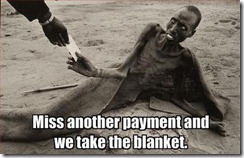Getting the 50,000 or three times the actual damages
 (b) After a trustee’s deed upon sale has been recorded, a mortgage
(b) After a trustee’s deed upon sale has been recorded, a mortgage
servicer, mortgagee, trustee, beneficiary, or authorized agent shall
be liable to a borrower for actual economic damages pursuant to
Section 3281, resulting from a material violation of Section 2923.55,
2923.6, 2923.7, 2924.9, 2924.10, 2924.11, or 2924.17 by that
mortgage servicer, mortgagee, trustee, beneficiary, or authorized
agent where the violation was not corrected and remedied prior to the
recordation of the trustee’s deed upon sale. If the court finds that
the material violation was intentional or reckless, or resulted from
willful misconduct by a mortgage servicer, mortgagee, trustee,
beneficiary, or authorized agent, the court may award the borrower
the greater of treble actual damages or statutory damages of fifty
thousand dollars ($50,000).
2923.55. (a) A mortgage servicer, mortgagee, trustee, beneficiary,
or authorized agent may not record a notice of default pursuant to
Section 2924 until all of the following:
(1) The mortgage servicer has satisfied the requirements of
paragraph (1) of subdivision (b).
(2) Either 30 days after initial contact is made as required by
paragraph (2) of subdivision (b) or 30 days after satisfying the due
diligence requirements as described in subdivision (f).
(3) The mortgage servicer complies with subdivision (c) of Section
2923.6, if the borrower has provided a complete application as
defined in subdivision (h) of Section 2923.6.
(b) (1) As specified in subdivision (a), a mortgage servicer shall
send the following information in writing to the borrower:
(A) A statement that if the borrower is a servicemember or a
dependent of a servicemember, he or she may be entitled to certain
protections under the federal Servicemembers Civil Relief Act (50
U.S.C. Appen. Sec. 501 et seq.) regarding the servicemember’s
interest rate and the risk of foreclosure, and counseling for covered
servicemembers that is available at agencies such as Military
OneSource and Armed Forces Legal Assistance.
(B) A statement that the borrower may request the following:
(i) A copy of the borrower’s promissory note or other evidence of
indebtedness.
(ii) A copy of the borrower’s deed of trust or mortgage.
(iii) A copy of any assignment, if applicable, of the borrower’s
mortgage or deed of trust required to demonstrate the right of the
mortgage servicer to foreclose.
(iv) A copy of the borrower’s payment history since the borrower
was last less than 60 days past due.
(2) A mortgage servicer shall contact the borrower in person or by
telephone in order to assess the borrower’s financial situation and
explore options for the borrower to avoid foreclosure. During the
initial contact, the mortgage servicer shall advise the borrower that
he or she has the right to request a subsequent meeting and, if
requested, the mortgage servicer shall schedule the meeting to occur
within 14 days. The assessment of the borrower’s financial situation
and discussion of options may occur during the first contact, or at
the subsequent meeting scheduled for that purpose. In either case,
the borrower shall be provided the toll-free telephone number made
available by the United States Department of Housing and Urban
Development (HUD) to find a HUD-certified housing counseling agency.
Any meeting may occur telephonically.
(c) A notice of default recorded pursuant to Section 2924 shall
include a declaration that the mortgage servicer has contacted the
borrower, has tried with due diligence to contact the borrower as
required by this section, or that no contact was required because the
individual did not meet the definition of “borrower” pursuant to
subdivision (c) of Section 2920.5.
(d) A mortgage servicer’s loss mitigation personnel may
participate by telephone during any contact required by this section.
(e) A borrower may designate, with consent given in writing, a
HUD-certified housing counseling agency, attorney, or other adviser
to discuss with the mortgage servicer, on the borrower’s behalf, the
borrower’s financial situation and options for the borrower to avoid
foreclosure. That contact made at the direction of the borrower shall
satisfy the contact requirements of paragraph (2) of subdivision
(b). Any foreclosure prevention alternative offered at the meeting by
the mortgage servicer is subject to approval by the borrower.
(f) A notice of default may be recorded pursuant to Section 2924
when a mortgage servicer has not contacted a borrower as required by
paragraph (2) of subdivision (b), provided that the failure to
contact the borrower occurred despite the due diligence of the
mortgage servicer. For purposes of this section, “due diligence”
shall require and mean all of the following:
(1) A mortgage servicer shall first attempt to contact a borrower
by sending a first-class letter that includes the toll-free telephone
number made available by HUD to find a HUD-certified housing
counseling agency.
(2) (A) After the letter has been sent, the mortgage servicer
shall attempt to contact the borrower by telephone at least three
times at different hours and on different days. Telephone calls shall
be made to the primary telephone number on file.
(B) A mortgage servicer may attempt to contact a borrower using an
automated system to dial borrowers, provided that, if the telephone
call is answered, the call is connected to a live representative of
the mortgage servicer.
(C) A mortgage servicer satisfies the telephone contact
requirements of this paragraph if it determines, after attempting
contact pursuant to this paragraph, that the borrower’s primary
telephone number and secondary telephone number or numbers on file,
if any, have been disconnected.
(3) If the borrower does not respond within two weeks after the
telephone call requirements of paragraph (2) have been satisfied, the
mortgage servicer shall then send a certified letter, with return
receipt requested, that includes the toll-free telephone number made
available by HUD to find a HUD-certified housing counseling agency.
(4) The mortgage servicer shall provide a means for the borrower
to contact it in a timely manner, including a toll-free telephone
number that will provide access to a live representative during
business hours.
(5) The mortgage servicer has posted a prominent link on the
homepage of its Internet Web site, if any, to the following
information:
(A) Options that may be available to borrowers who are unable to
afford their mortgage payments and who wish to avoid foreclosure, and
instructions to borrowers advising them on steps to take to explore
those options.
(B) A list of financial documents borrowers should collect and be
prepared to present to the mortgage servicer when discussing options
for avoiding foreclosure.
(C) A toll-free telephone number for borrowers who wish to discuss
options for avoiding foreclosure with their mortgage servicer.
(D) The toll-free telephone number made available by HUD to find a
HUD-certified housing counseling agency.
(g) This section shall not apply to entities described in
subdivision (b) of Section 2924.18.
(h) This section shall apply only to mortgages or deeds of trust
described in Section 2924.15.
(i) This section shall remain in effect only until January 1,
2018, and as of that date is repealed, unless a later enacted
statute, that is enacted before January 1, 2018, deletes or extends
that date.
2923.6. (a) The Legislature finds and declares that any duty that
mortgage servicers may have to maximize net present value under their
pooling and servicing agreements is owed to all parties in a loan
pool, or to all investors under a pooling and servicing agreement,
not to any particular party in the loan pool or investor under a
pooling and servicing agreement, and that a mortgage servicer acts in
the best interests of all parties to the loan pool or investors in
the pooling and servicing agreement if it agrees to or implements a
loan modification or workout plan for which both of the following
apply:
(1) The loan is in payment default, or payment default is
reasonably foreseeable.
(2) Anticipated recovery under the loan modification or workout
plan exceeds the anticipated recovery through foreclosure on a net
present value basis.
(b) It is the intent of the Legislature that the mortgage servicer
offer the borrower a loan modification or workout plan if such a
modification or plan is consistent with its contractual or other
authority.
(c) If a borrower submits a complete application for a first lien
loan modification offered by, or through, the borrower’s mortgage
servicer, a mortgage servicer, mortgagee, trustee, beneficiary, or
authorized agent shall not record a notice of default or notice of
sale, or conduct a trustee’s sale, while the complete first lien loan
modification application is pending. A mortgage servicer, mortgagee,
trustee, beneficiary, or authorized agent shall not record a notice
of default or notice of sale or conduct a trustee’s sale until any of
the following occurs:
(1) The mortgage servicer makes a written determination that the
borrower is not eligible for a first lien loan modification, and any
appeal period pursuant to subdivision (d) has expired.
(2) The borrower does not accept an offered first lien loan
modification within 14 days of the offer.
(3) The borrower accepts a written first lien loan modification,
but defaults on, or otherwise breaches the borrower’s obligations
under, the first lien loan modification.
(d) If the borrower’s application for a first lien loan
modification is denied, the borrower shall have at least 30 days from
the date of the written denial to appeal the denial and to provide
evidence that the mortgage servicer’s determination was in error.
(e) If the borrower’s application for a first lien loan
modification is denied, the mortgage servicer, mortgagee, trustee,
beneficiary, or authorized agent shall not record a notice of default
or, if a notice of default has already been recorded, record a
notice of sale or conduct a trustee’s sale until the later of:
(1) Thirty-one days after the borrower is notified in writing of
the denial.
(2) If the borrower appeals the denial pursuant to subdivision
(d), the later of 15 days after the denial of the appeal or 14 days
after a first lien loan modification is offered after appeal but
declined by the borrower, or, if a first lien loan modification is
offered and accepted after appeal, the date on which the borrower
fails to timely submit the first payment or otherwise breaches the
terms of the offer.
(f) Following the denial of a first lien loan modification
application, the mortgage servicer shall send a written notice to the
borrower identifying the reasons for denial, including the
following:
(1) The amount of time from the date of the denial letter in which
the borrower may request an appeal of the denial of the first lien
loan modification and instructions regarding how to appeal the
denial.
(2) If the denial was based on investor disallowance, the specific
reasons for the investor disallowance.
(3) If the denial is the result of a net present value
calculation, the monthly gross income and property value used to
calculate the net present value and a statement that the borrower may
obtain all of the inputs used in the net present value calculation
upon written request to the mortgage servicer.
(4) If applicable, a finding that the borrower was previously
offered a first lien loan modification and failed to successfully
make payments under the terms of the modified loan.
(5) If applicable, a description of other foreclosure prevention
alternatives for which the borrower may be eligible, and a list of
the steps the borrower must take in order to be considered for those
options. If the mortgage servicer has already approved the borrower
for another foreclosure prevention alternative, information necessary
to complete the foreclosure prevention alternative.
(g) In order to minimize the risk of borrowers submitting multiple
applications for first lien loan modifications for the purpose of
delay, the mortgage servicer shall not be obligated to evaluate
applications from borrowers who have already been evaluated or
afforded a fair opportunity to be evaluated for a first lien loan
modification prior to January 1, 2013, or who have been evaluated or
afforded a fair opportunity to be evaluated consistent with the
requirements of this section, unless there has been a material change
in the borrower’s financial circumstances since the date of the
borrower’s previous application and that change is documented by the
borrower and submitted to the mortgage servicer.
(h) For purposes of this section, an application shall be deemed
“complete” when a borrower has supplied the mortgage servicer with
all documents required by the mortgage servicer within the reasonable
timeframes specified by the mortgage servicer.
(i) Subdivisions (c) to (h), inclusive, shall not apply to
entities described in subdivision (b) of Section 2924.18.
(j) This section shall apply only to mortgages or deeds of trust
described in Section 2924.15.
(k) This section shall remain in effect only until January 1,
2018, and as of that date is repealed, unless a later enacted
statute, that is enacted before January 1, 2018, deletes or extends
that date.
2923.7. (a) Upon request from a borrower who requests a foreclosure
prevention alternative, the mortgage servicer shall promptly
establish a single point of contact and provide to the borrower one
or more direct means of communication with the single point of
contact.
(b) The single point of contact shall be responsible for doing all
of the following:
(1) Communicating the process by which a borrower may apply for an
available foreclosure prevention alternative and the deadline for
any required submissions to be considered for these options.
(2) Coordinating receipt of all documents associated with
available foreclosure prevention alternatives and notifying the
borrower of any missing documents necessary to complete the
application.
(3) Having access to current information and personnel sufficient
to timely, accurately, and adequately inform the borrower of the
current status of the foreclosure prevention alternative.
(4) Ensuring that a borrower is considered for all foreclosure
prevention alternatives offered by, or through, the mortgage
servicer, if any.
(5) Having access to individuals with the ability and authority to
stop foreclosure proceedings when necessary.
(c) The single point of contact shall remain assigned to the
borrower’s account until the mortgage servicer determines that all
loss mitigation options offered by, or through, the mortgage servicer
have been exhausted or the borrower’s account becomes current.
(d) The mortgage servicer shall ensure that a single point of
contact refers and transfers a borrower to an appropriate supervisor
upon request of the borrower, if the single point of contact has a
supervisor.
(e) For purposes of this section, “single point of contact” means
an individual or team of personnel each of whom has the ability and
authority to perform the responsibilities described in subdivisions
(b) to (d), inclusive. The mortgage servicer shall ensure that each
member of the team is knowledgeable about the borrower’s situation
and current status in the alternatives to foreclosure process.
(f) This section shall apply only to mortgages or deeds of trust
described in Section 2924.15.
(g) (1) This section shall not apply to a depository institution
chartered under state or federal law, a person licensed pursuant to
Division 9 (commencing with Section 22000) or Division 20 (commencing
with Section 50000) of the Financial Code, or a person licensed
pursuant to Part 1 (commencing with Section 10000) of Division 4 of
the Business and Professions Code, that, during its immediately
preceding annual reporting period, as established with its primary
regulator, foreclosed on 175 or fewer residential real properties,
containing no more than four dwelling units, that are located in
California.
(2) Within three months after the close of any calendar year or
annual reporting period as established with its primary regulator
during which an entity or person described in paragraph (1) exceeds
the threshold of 175 specified in paragraph (1), that entity shall
notify its primary regulator, in a manner acceptable to its primary
regulator, and any mortgagor or trustor who is delinquent on a
residential mortgage loan serviced by that entity of the date on
which that entity will be subject to this section, which date shall
be the first day of the first month that is six months after the
close of the calendar year or annual reporting period during which
that entity exceeded the threshold.
2924.9. (a) Unless a borrower has previously exhausted the first
lien loan modification process offered by, or through, his or her
mortgage servicer described in Section 2923.6, within five business
days after recording a notice of default pursuant to Section 2924, a
mortgage servicer that offers one or more foreclosure prevention
alternatives shall send a written communication to the borrower that
includes all of the following information:
(1) That the borrower may be evaluated for a foreclosure
prevention alternative or, if applicable, foreclosure prevention
alternatives.
(2) Whether an application is required to be submitted by the
borrower in order to be considered for a foreclosure prevention
alternative.
(3) The means and process by which a borrower may obtain an
application for a foreclosure prevention alternative.
(b) This section shall not apply to entities described in
subdivision (b) of Section 2924.18.
(c) This section shall apply only to mortgages or deeds of trust
described in Section 2924.15.
(d) This section shall remain in effect only until January 1,
2018, and as of that date is repealed, unless a later enacted
statute, that is enacted before January 1, 2018, deletes or extends
that date.
2924.10. (a) When a borrower submits a complete first lien
modification application or any document in connection with a first
lien modification application, the mortgage servicer shall provide
written acknowledgment of the receipt of the documentation within
five business days of receipt. In its initial acknowledgment of
receipt of the loan modification application, the mortgage servicer
shall include the following information:
(1) A description of the loan modification process, including an
estimate of when a decision on the loan modification will be made
after a complete application has been submitted by the borrower and
the length of time the borrower will have to consider an offer of a
loan modification or other foreclosure prevention alternative.
(2) Any deadlines, including deadlines to submit missing
documentation, that would affect the processing of a first lien loan
modification application.
(3) Any expiration dates for submitted documents.
(4) Any deficiency in the borrower’s first lien loan modification
application.
(b) For purposes of this section, a borrower’s first lien loan
modification application shall be deemed to be “complete” when a
borrower has supplied the mortgage servicer with all documents
required by the mortgage servicer within the reasonable timeframes
specified by the mortgage servicer.
(c) This section shall not apply to entities described in
subdivision (b) of Section 2924.18.
(d) This section shall apply only to mortgages or deeds of trust
described in Section 2924.15.
(e) This section shall remain in effect only until January 1,
2018, and as of that date is repealed, unless a later enacted
statute, that is enacted before January 1, 2018, deletes or extends
that date.
2924.11. (a) If a foreclosure prevention alternative is approved in
writing prior to the recordation of a notice of default, a mortgage
servicer, mortgagee, trustee, beneficiary, or authorized agent shall
not record a notice of default under either of the following
circumstances:
(1) The borrower is in compliance with the terms of a written
trial or permanent loan modification, forbearance, or repayment plan.
(2) A foreclosure prevention alternative has been approved in
writing by all parties, including, for example, the first lien
investor, junior lienholder, and mortgage insurer, as applicable, and
proof of funds or financing has been provided to the servicer.
(b) If a foreclosure prevention alternative is approved in writing
after the recordation of a notice of default, a mortgage servicer,
mortgagee, trustee, beneficiary, or authorized agent shall not record
a notice of sale or conduct a trustee’s sale under either of the
following circumstances:
(1) The borrower is in compliance with the terms of a written
trial or permanent loan modification, forbearance, or repayment plan.
(2) A foreclosure prevention alternative has been approved in
writing by all parties, including, for example, the first lien
investor, junior lienholder, and mortgage insurer, as applicable, and
proof of funds or financing has been provided to the servicer.
(c) When a borrower accepts an offered first lien loan
modification or other foreclosure prevention alternative, the
mortgage servicer shall provide the borrower with a copy of the fully
executed loan modification agreement or agreement evidencing the
foreclosure prevention alternative following receipt of the executed
copy from the borrower.
(d) A mortgagee, beneficiary, or authorized agent shall record a
rescission of a notice of default or cancel a pending trustee’s sale,
if applicable, upon the borrower executing a permanent foreclosure
prevention alternative. In the case of a short sale, the rescission
or cancellation of the pending trustee’s sale shall occur when the
short sale has been approved by all parties and proof of funds or
financing has been provided to the mortgagee, beneficiary, or
authorized agent.
(e) The mortgage servicer shall not charge any application,
processing, or other fee for a first lien loan modification or other
foreclosure prevention alternative.
(f) The mortgage servicer shall not collect any late fees for
periods during which a complete first lien loan modification
application is under consideration or a denial is being appealed, the
borrower is making timely modification payments, or a foreclosure
prevention alternative is being evaluated or exercised.
(g) If a borrower has been approved in writing for a first lien
loan modification or other foreclosure prevention alternative, and
the servicing of that borrower’s loan is transferred or sold to
another mortgage servicer, the subsequent mortgage servicer shall
continue to honor any previously approved first lien loan
modification or other foreclosure prevention alternative, in
accordance with the provisions of the act that added this section.
(h) This section shall apply only to mortgages or deeds of trust
described in Section 2924.15.
(i) This section shall not apply to entities described in
subdivision (b) of Section 2924.18.
(j) This section shall remain in effect only until January 1,
2018, and as of that date is repealed, unless a later enacted
statute, that is enacted before January 1, 2018, deletes or extends
that date.
2924.17. (a) A declaration recorded pursuant to Section 2923.5 or,
until January 1, 2018, pursuant to Section 2923.55, a notice of
default, notice of sale, assignment of a deed of trust, or
substitution of trustee recorded by or on behalf of a mortgage
servicer in connection with a foreclosure subject to the requirements
of Section 2924, or a declaration or affidavit filed in any court
relative to a foreclosure proceeding shall be accurate and complete
and supported by competent and reliable evidence.
(b) Before recording or filing any of the documents described in
subdivision (a), a mortgage servicer shall ensure that it has
reviewed competent and reliable evidence to substantiate the borrower’
s default and the right to foreclose, including the borrower’s loan
status and loan information.
(c) Until January 1, 2018, any mortgage servicer that engages in
multiple and repeated uncorrected violations of subdivision (b) in
recording documents or filing documents in any court relative to a
foreclosure proceeding shall be liable for a civil penalty of up to
seven thousand five hundred dollars ($7,500) per mortgage or deed of
trust in an action brought by a government entity identified in
Section 17204 of the Business and Professions Code, or in an
administrative proceeding brought by the Department of Business
Oversight or the Bureau of Real Estate against a respective licensee,
in addition to any other remedies available to these entities. This
subdivision shall be inoperative on January 1, 2018.



























 Finally, after trillions in fraudulent activity, trillions in bailouts, trillions in printed money, billions in political bribing and billions in bonuses, the criminal cartel members on Wall Street are beginning to get what they deserve. As the Eurozone is coming apart at the seams and as the US economy grinds to a halt, the financial elite are starting to turn on each other. The lawsuits are piling up fast. Here’s an extensive roundup:
Finally, after trillions in fraudulent activity, trillions in bailouts, trillions in printed money, billions in political bribing and billions in bonuses, the criminal cartel members on Wall Street are beginning to get what they deserve. As the Eurozone is coming apart at the seams and as the US economy grinds to a halt, the financial elite are starting to turn on each other. The lawsuits are piling up fast. Here’s an extensive roundup: Time to put your Big Bank
Time to put your Big Bank  Is the Goldman Sachs CEO facing a new lawsuit?
Is the Goldman Sachs CEO facing a new lawsuit? Another day, another trillion plus in secret Federal Reserve “bailouts” revealed. Bloomberg News exposes this latest Fed “deal” after winning a long Freedom of Information Act (FOIA) legal battle to get the details on what was done with the American people’s money. Their report runs with an AmpedStatus style headline: “Wall Street Aristocracy Got $1.2 Trillion From Fed.”
Another day, another trillion plus in secret Federal Reserve “bailouts” revealed. Bloomberg News exposes this latest Fed “deal” after winning a long Freedom of Information Act (FOIA) legal battle to get the details on what was done with the American people’s money. Their report runs with an AmpedStatus style headline: “Wall Street Aristocracy Got $1.2 Trillion From Fed.”
 <=”” a=””>
<=”” a=””> <=”” a=””>
<=”” a=””> <=”” a=””>
<=”” a=””> <=”” a=””>
<=”” a=””> <=”” a=””>
<=”” a=””> <=”” a=””>
<=”” a=””> <=”” a=””>
<=”” a=””> <=”” a=””>
<=”” a=””> <=”” a=””>
<=”” a=””> <=”” a=””>
<=”” a=””> <=”” a=””>
<=”” a=””> <=”” a=””>
<=”” a=””> <=”” a=””>
<=”” a=””> <=”” a=””>
<=”” a=””> <=”” a=””>
<=”” a=””> <=”” a=””>
<=”” a=””> <=”” a=””>
<=”” a=””> <=”” a=””>
<=”” a=””> <=”” a=””>
<=”” a=””> <=”” a=””>
<=”” a=””> <=”” a=””>
<=”” a=””> <=”” a=””>
<=”” a=””> <=”” a=””>
<=”” a=””> <=”” a=””>
<=”” a=””> <=”” a=””>
<=”” a=””> <=”” a=””>
<=”” a=””> <=”” a=””>
<=”” a=””> <=”” a=””>
<=”” a=””>











 by Pat Garafolo, Over the weekend, the Washington Post provided some more details about the
by Pat Garafolo, Over the weekend, the Washington Post provided some more details about the 
















